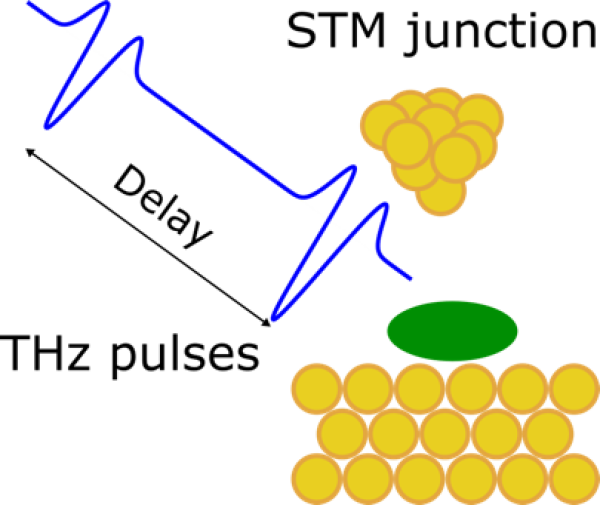Research

THz-STM
Ultrafast dynamics of adsorbed nanoobjects
Scanning tunneling microscopy (STM), owing to its high spatial resolution (sub nanometer), is a tool of choice to investigate, address and manipulate single nanoobjects adsorbed on surfaces. Many of the investigated nanoobjects, be it atoms, molecules or nanostructures, exhibit rich dynamics such as charge transfer, spin/vibration excitation and change of conformation, which are usually too fast to be resolved using typical STM instrumentation. This is because the main quantity being measured, the tunneling current, is relatively small (sub nanoampere), and its detection is typically slow (time resolution on the order of millisecond for conventional instruments).
To overcome the time resolution of the detector, measurements can be performed in a stroboscopic manner as done in the field of ultrafast optics. Pump and probe voltage pulses, with an adjustable delay between them, are repeatedly applied to the sample. The dynamics of the investigated systems are inferred from the evolution of the corresponding quasi-static tunneling current as a function of the delay between the pulses. Loth and coworkers have implemented this concept in STM using an all-electronic scheme [LOT10]. They reached a time resolution on the order of 10 ns, which is essentially dictated by the ability of the wires to transmit fast pulses with limited distortion. To overcome limitations due to the wiring, Cocker and coworkers used electromagnetic THz pulses to effectively induce ultrafast voltage transients in the STM junction [COC13], which was for instance employed to track the ultrafast motion of a single molecule with a sub-picosecond time resolution [COC16].
In a close collaboration with the group of Rolf Möller, we are implementing THz STM on a custom-made STM and using commercial THz emitters. We aim at investigating various ultrafast dynamics of individual adsorbates on surfaces at variable temperatures (10 to 300 K) under ultra-high vacuum.
[LOT10] Loth et al., Science 329, 1628 (2010).





